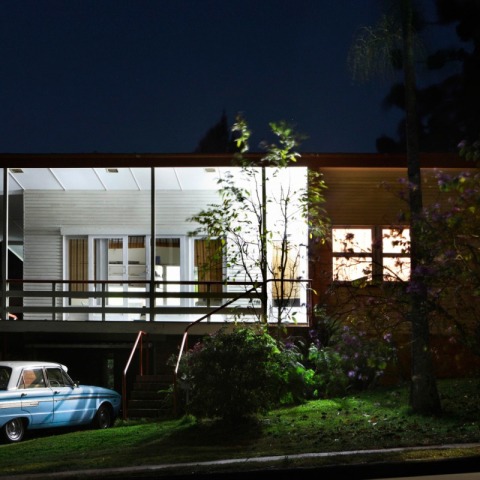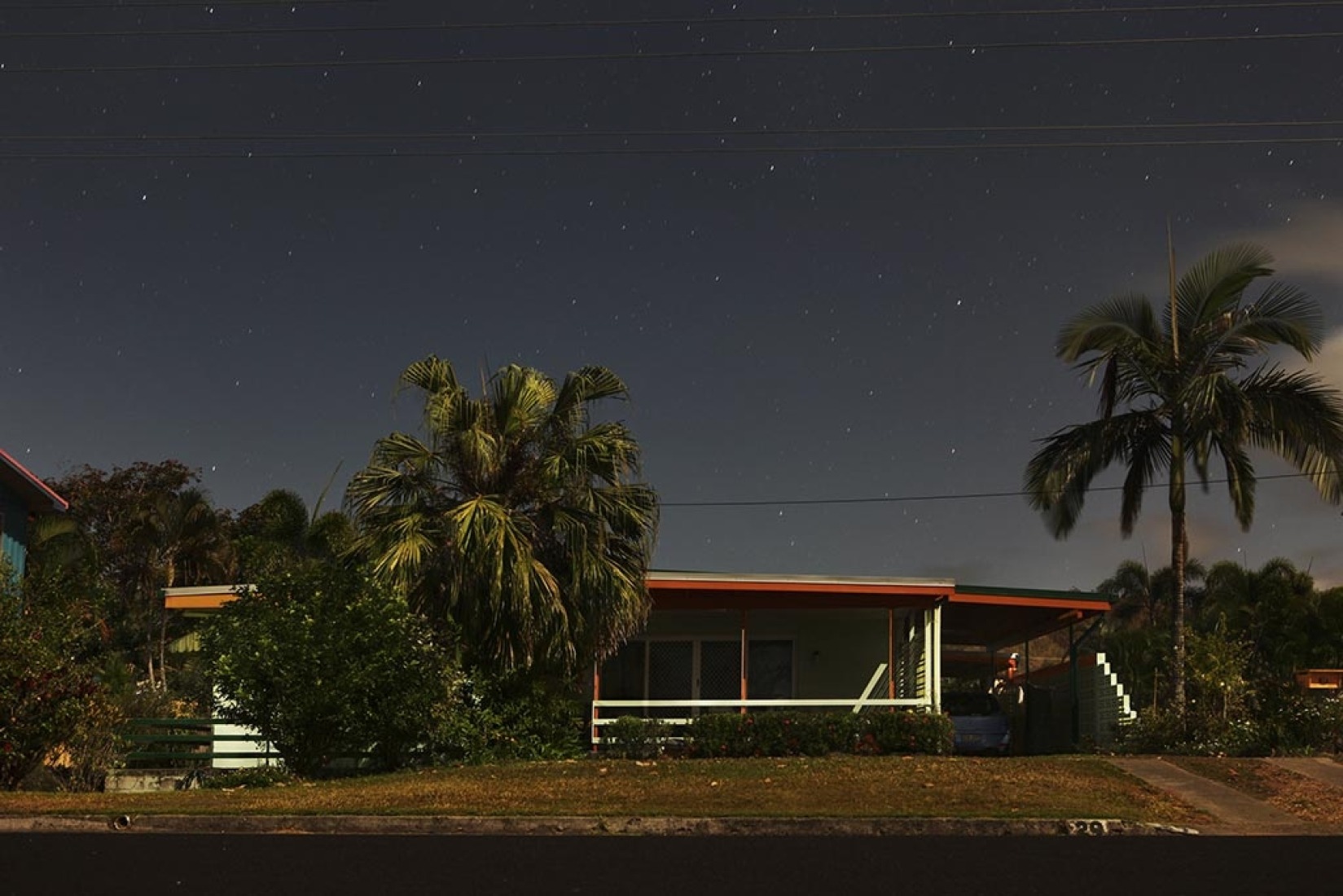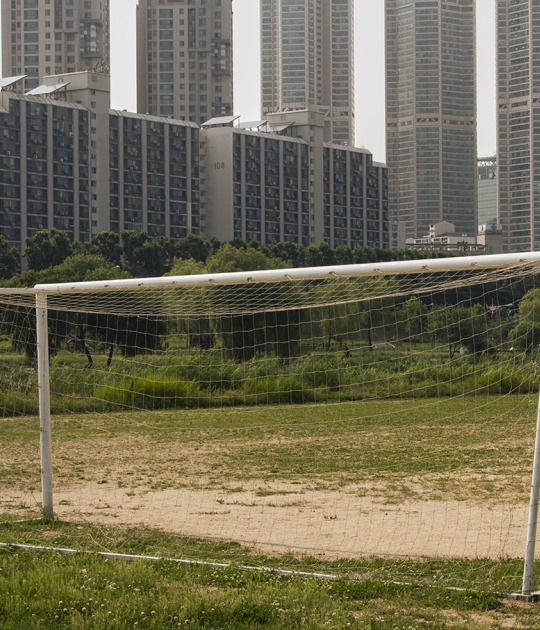This work by Carlos Givaja takes place in the young nation of Australia that despite the influence of England has developed more parallel conditions to urban situations that exist in The United States. The Australian houses of this project show the family unit as a private space within a vast territory largely depopulated. Using the appearance of homes as a link, the photographer will give us the opportunity to meet lifestyles, conditions and particularities in order to, intentionally, let us compare through our imaginary with the U.S. and its "American dream".
Text on exhibition by Miguel Pita
A trip through the east coast of Australia inspires Carlos Givaja, who for this project is focusing on the similarities between the American and the Australian cultural imagery through domestic architecture.
Shot at night, just with a camera and a tripod, these single-family homes are used as scenarios to speak about their protagonists.
Through the "objectification" of people who live in these houses, the photographs leave us to imagine thelife styles through the asphalt, the cars, the boats and those half-hidden interiors so intimately portrayed. These are images talking about the lifestyle of these Australian communities that bring to us memories of the "American Dream".
Australia is culturally a Western country and therefore shares roots with its close relatives, Europe and North America, in present times as much as in the past: they consume the same multinational products, read the same best-sellers, watch the same movies, use the same brands for clothes, and business men populate large cities moving at fast speeds with their ties and suits...But what nobody tells you beforehand is that when you arrive in Australia, it reminds you of the U.S., or of the idea that we have built of that country through the imagery that it exports worldwide.
Both young nations have modeled their identity from the characteristics and customs of England, but visiting this country/continent one discovers that physically, its architectural and urban aspects, do not look much like her motherland, but resemble the U.S. instead.
It seems that the way of living is the main enhancer of this similarity: big houses with a garden, one car per person, parabolicdishes, daily life that starts jumping from the house to the car... And one can find a lot of reasons to understand this similarity: first the huge expansion of land occupied by both countries, leading to some depopulation that unfailingly models society.
A large country allows its inhabitants to establish homes more spaciously. Both in large and in small cities, the inhabitants prefer to live in individual private properties away from the urban centers, and this forces the use of cars, and also because there is no council that is able to nurture a public transport system with convenient stops to all the people living far apart from one another.
There is another purely historical reason related to colonization that explains the resemblance between Australia-U.S. Both countries were filled with settlers who came to a wild land and made it their own, and in many cases had to make use of force to defend it, as books and movies have already told us. The detached house with land around it is the inheritance of those small personal victories. Perhaps that is why the satisfaction of cleaning the pool or repairing the windows or the shed of the house for an Australian or an American, are difficult to understand and considered boring tasks from the European perspective.
Probably detached housing is the solution to which both societies have grown into independently, and to a lesser extent it is also the result of mutual imitation, or a shared heritage of their common ancestor. Two Western societies, both less than three centuries old, daughters of England, with parallel lives, have found their great economic development in the age of oil, and so similar stories occur. It is very similar at least in the facade.
Looking closely, the same edifications that show similarity between the two societies also unveil nuances that reveal important distinctions. No doubt that American society is much more ambitious, and the Australian is more idle. A sign of Australian identity is their passion forsports and the devotion to it from people of all ages and life conditions. The desire to live close to the beach is a particularly prominent feature in Australia too, which in many cases outweighs the characteristics of the building itself, often not particularly well consolidated. Certainly the need for a place to store water-sport accessories, often large, also justifies the need for that big house, that space itself, and those houses full of toys are many in Australia.
Facing the fear and mistrust that shows the average U.S. citizen, who prefers to rely on the dictates of TV than to rely on their neighbor. In Australia the living spaces reveal that the society is relaxedwith open doors and outdoor living. In Australia relaxation is an identity sign.
The Australian house apart from an open house, in many cases may be a flimsy or prefabricated building, and that is not only in the case of the mentioned beach houses, but any house. This situation is probably enhanced by some nomadic passion with frequent complete family house shifts. One can speculate that perhaps this is a trait inherited from their colonial past (less latent in the U.S., except for reasons of study or work), but also from their interest in travelling across their country.
The house reflects the family which is the unit in which most societies are organized, and as we have already mentioned, is the opposite of the American Fort, the Australian home is a refuge, but also a small conquered square. In the Australian case it is compared to nature because it is the world's only developed country with the wildest nature. Proceeding from countries where man´s hand has tamed the fields making its surface almost entirely cultivable, the most impressive of Australia is its exuberance, nature invading cities, which have not yet fully won their battle with it, as seenthrough their victorious skies full of stars, which do not know the night blackout produced by light pollution.
Dates.- From 6th to 28th of April, 2013.
Venue.- C/ San Lucas 9, 28004. Madrid. Spain. Tel. +34 91 308 2325.
Translator.- Horacio Basilicus.
Curator.- Nicolas Bénac for the third edition of "Jugada a tres bandas" in Madrid.
Sound atmosphere by Pablo Barahona.




























